‘The Suit Doctor’ Mark Van Roosmalen
Three Generations of Tailors
Listen to this storyThere were so many; there was Austin Brown, there was Minerva Gowns (my Grandmothers), Paragon Fashions, Stylemaster, Cotura (these are all in Lichfield Street), Cotura... who else... Dougals manufacturing and just around the corner there was Zenith tailors and a fur shop manufacturer…
Mark Van Roosmalen
The Wellington Woollen Manufacturing Company began near Wellington in 1886. The company manufactured knitted and woven goods for the New Zealand market. Around 1906-1907 its success enabled it to open a branch in Christchurch, and twelve years later it built a new warehouse and clothing factory in the centre of the city. This was designed by William Henry Gummer (1884-1966). His firm was responsible for many significant buildings, including the Auckland Railway Station and the former National Art Gallery and Museum in Wellington. In addition, Gummer was responsible for a number of significant First World War memorials, such as Christchurch’s Bridge of Remembrance.
For the Wellington Woollen Manufacturing Company, Gummer produced a four-storeyed building supported by a grid of 40 reinforced concrete columns. Because the weight of the building was supported by these columns, rather than the external walls, Gummer was able to sheath the first and second floors in glass. Unglazed areas of the main facade of the building were clad in Nelson marble and decorated in a pared-down classical style, favoured by Gummer, reflecting the influence of American architects of the period. A significant feature of the building was the light-well through the first, second and third floors, which provided natural light to the building from skylights set in the saw-toothed roof. Regrettably the light-well was filled in during the 1980s.
A significant example of Gummer's commercial architecture, this building gave the Wellington Woollen Manufacturing Company a progressive and distinctive image, as well as a facility that met practical requirements. Its use of large glazed areas and the paring back of decoration foreshadows the introduction of architecture of the Modern Movement to New Zealand. The building forms an important part of the commercial townscape of Lichfield Street.
-

Lichfield Street Rag Traders. Image: Doc Ross
Building information
Former Wellington Woollen Mills96 Lichfield St
Built: 1919
Designed by: William Henry Gummer
Category 1
Historic Place